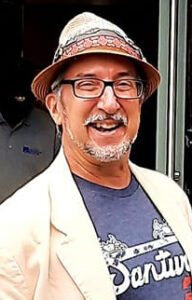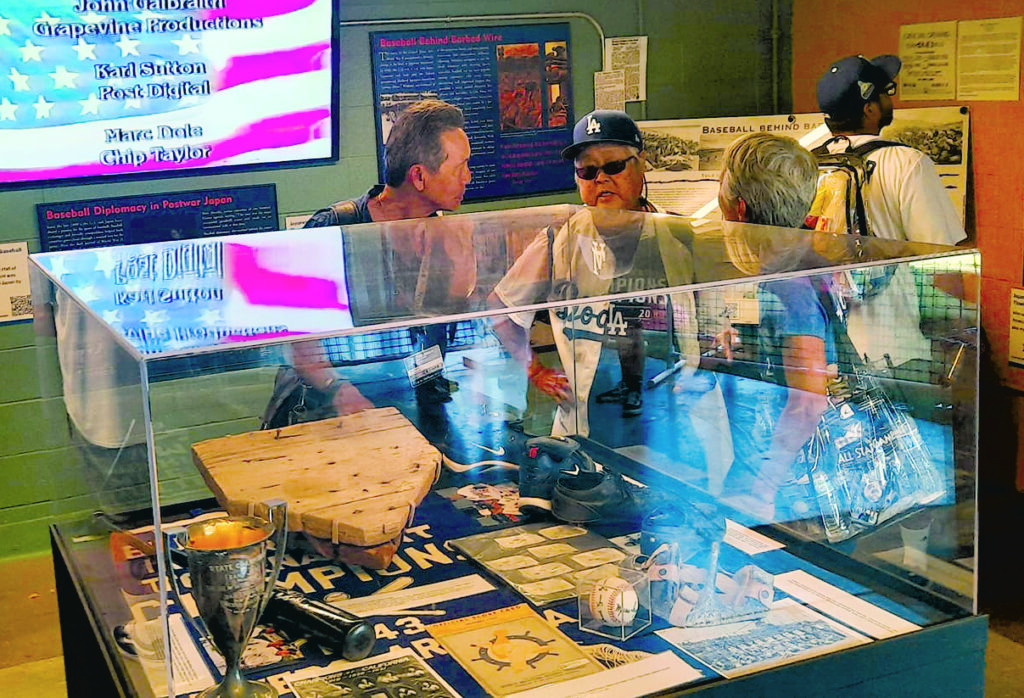Baseball’s Bridge to the Pacific
Exhibit at Dodger Stadium
By Charlie Vascellaro

These days it would be hard to imagine Major League Baseball without the contributions made by Japanese stars like Shohei Ohtani, the game’s top marquee attraction, or impending Hall of Fame inductee Ichiro Suzuki, or the stir created by Hideo “The Tornado” Nomo, when he made his big-league debut with the Los Angeles Dodgers in 1995. Nomo was preceded by pitcher Masanori “Mashi” Murakami as the first Japanese player in the major leagues signing with the San Francisco Giants in 1964.
Despite the fact that baseball has been popular in Japan almost as long as it has been recognized as the national game in the United States, the history of Japanese lengthy involvement in baseball is celebrating its 150th anniversary this year and is depicted by “Baseball’s Bridge to the Pacific: Celebrating the Legacy of Japanese American Baseball” an exhibit currently on display at Dodger Stadium in Los Angeles.
The game was introduced to Japan in the 1870s by an American school teacher named Horace Wilson, who was teaching English to Japanese children at Kaisei Gakko School, which is now the site of Tokyo University.
For about a decade now I’ve been assisting in the creation of baseball museum installations and exhibits at museums and libraries in Scottsdale, and Mesa, Arizona in conjunction with the state’s Cactus League spring training season. Most of the content contained in our exhibits concerns spring training history in Arizona dating back to the Cactus League’s inception in 1947 the same year that Jackie Robinson made his pioneering debut as Major League Baseball’s first black player.

Much of the baseball history explored in our museum exhibits also studies social and cultural American history extending outside of the foul lines and far beyond the outfield walls including issues such as segregation, integration, exclusion, inclusion, and civil rights.
During the spring of 2018 part of a museum exhibit commemorating inductees into the Cactus League Hall of Fame included long-time Chicago Cubs clubhouse manager Yosh Kawano whose amazing journey to the big leagues was temporarily derailed when he and his family were among 100,000 Americans of Japanese descent who were forcibly removed from their homes and detained in incarceration camps indefinitely. The Kawano family was sent to the Poston War Relocation Center on the Colorado River Indian Reservation near Yuma in hot and dusty southwestern Arizona.
Upon learning this significant part of Kawano’s story, the narrative of our museum installation expanded into another dimension. Baseball was still the running theme and remained an important component enhanced by the inclusion of baseball leagues created within the confines of the World War II camps. Created by Kenichi Zenimura, known as “The Dean of the Diamond” and the “Father of Japanese American Baseball,” the intercamp leagues became a huge component of the exhibit’s narrative and we were able to procure some remarkable historic artifacts on loan from descendants of those imprisoned in the camps.
I had previously written on this topic back in 1997 when I first met Kerry Yo Nakagawa, the Director of the Nisei Baseball Research Project at the Arizona State Hall of Fame Museum where he had recently installed his “Diamonds in the Rough, Japanese Americans in Baseball” exhibit. A few months later the exhibit was relocated the National Baseball Hall of Fame in Cooperstown.
The original home plate from Zenimura Field at the camp in Gila River, AZ was also included in the touring “Baseball as America” exhibit and later re-installed as part of the Hall of Fame’s timeline exhibit. It’s now a centerpiece in the “Baseball’s Bridge to the Pacific” exhibit currently on display at Dodger Stadium in Los Angeles, Calif.
Installed in conjunction with Japanese American Heritage night at Dodger Stadium on June 15, the exhibit has been met with rave reviews as part of the recent All-Star Game and Home Run Derby festivities at Dodger Stadium July 18-19 and remains on display along the Left Field Pavilion.
Legacy of Japanese American Baseball celebrated at Dodger Stadium (mlb.com) “I am very proud of my Japanese heritage and honored to be managing a team with such a rich and pioneering history,” said Dave Roberts, Manager, Los Angeles Dodgers at the ribbon cutting ceremony (Press release: Dodgers to host Japanese Heritage Night on Wednesday, June 15 (mlb.com)). “Having played with and managed both Japanese and Japanese American players, it has been a privilege to help cultivate a sense of how much alike we truly are through the teaching of this wonderful game. Throughout time and under varied circumstances, baseball has always brought people together and as the Dodgers’ manager, I take great pride in helping lead the franchise at the forefront of Pacific Rim baseball.”
Created as a partnership between the Arizona Baseball Legacy and Experience and the Nisei Baseball Research Project the exhibit opened at the Mesa Historical Museum as part of the “Play Ball: The Arizona Spring Training Experience & Cactus League Hall of Fame,” exhibit on February 26, 2022.
Members of the Dodgers front office caught a glimpse of our exhibit on Japanese Baseball History at the Mesa Historical Museum in Mesa, AZ during the 2022 Cactus League spring training season and expressed and interest to bring it to Dodger Stadium for Japanese American Heritage Night and the All-Star Game as part of an ongoing outreach to the Asian Community in Los Angeles.
“We’re very honored to be here to share with fans all this hidden legacy and history of these marginalized, invisible and forgotten ballplayers, is what I call them,” said Kerry Yo Nakagawa, director of the NBRP and the exhibit’s founding curator.
Charlie Vascellaro is a long-time contributor to The Freeman’s Journal, Hometown Oneonta and Allotsego.com. He is usually in Cooperstown covering the Induction but was away this year to bring this important exhibit to Dodger Stadium.

